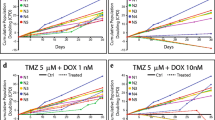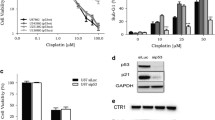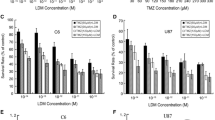Abstract
Temozolomide is a standard chemotherapy agent for malignant gliomas, but the efficacy is still not satisfactory. Therefore, combination chemotherapy using temozolomide with other anti-tumor compounds is now under investigation. Here we studied the mechanism of the synergistic anti-tumor effect achieved by temozolomide and doxorubicin, and elucidated the inhibitory effect of temozolomide on P-glycoprotein (P-gp). Temozolomide significantly enhanced sensitivity to P-gp substrate in glioma cells, particularly in P-gp-overexpressed cells. Synergetic effects, as determined by isobologram analysis, were observed by combining temozolomide and doxorubicin. Subsequently, flow cytometry was utilized to assess the intracellular retention of doxorubicin in cells treated with doxorubicin with or without temozolomide. Temozolomide significantly increased the accumulation of doxorubicin in these cells. The P-gp adenosine triphosphatase (ATPase) assay showed that temozolomide inhibited the ATPase activity of P-gp. In addition, temozolomide combined with doxorubicin significantly prolonged the survival of 9L intracranial allografted glioma-bearing rats compared to single agent treatment. Collectively, our findings suggest that temozolomide can reverse doxorubicin resistance by directly affecting P-gp transport activity. Combination chemotherapy using temozolomide with other agents may be effective against gliomas in clinical applications.




Similar content being viewed by others
References
Grossman SA, Ye X, Piantadosi S, Desideri S, Nabors LB, Rosenfeld M, Fisher J (2010) Survival of patients with newly diagnosed glioblastoma treated with radiation and temozolomide in research studies in the United States. Clin Cancer Res 16(8):2443–2449
Balzarotti M, Ciusani E, Calatozzolo C, Croci D, Boiardi A, Salmaggi A (2004) Effect of association of temozolomide with other chemotherapic agents on cell growth inhibition in glioma cell lines. Oncol Res 14(7–8):325–330
Caraglia M, Addeo R, Costanzo R, Montella L, Faiola V, Marra M, Abbruzzese A, Palmieri G, Budillon A, Grillone F, Venuta S, Tagliaferri P, Del Prete S (2006) Phase II study of temozolomide plus pegylated liposomal doxorubicin in the treatment of brain metastases from solid tumours. Cancer Chemother Pharmacol 57(1):34–39
Ananda S, Nowak AK, Cher L, Dowling A, Brown C, Simes J, Rosenthal MA (2011) Phase 2 trial of temozolomide and pegylated liposomal doxorubicin in the treatment of patients with glioblastoma multiforme following concurrent radiotherapy and chemotherapy. J Clin Neurosci 18(11):1444–1448
Kikuchi T, Saito R, Sugiyama S, Yamashita Y, Kumabe T, Krauze M, Bankiewicz K, Tominaga T (2008) Convection-enhanced delivery of polyethylene glycol-coated liposomal doxorubicin: characterization and efficacy in rat intracranial glioma models. J Neurosurg 109(5):867–873
Twentyman PR (1992) MDR1 (P-glycoprotein) gene expression-implications for resistance modifier trials. J Natl Cancer Inst 84(19):1458–1460
Cole SP, Deeley RG (1998) Multidrug resistance mediated by the ATP-binding cassette transporter protein MRP. BioEssays 20(11):931–940
Bredel M, Zentner J (2002) Brain-tumour drug resistance: the bare essentials. Lancet Oncol 3(7):397–406
Abe T, Mori T, Wakabayashi Y, Nakagawa M, Cole SP, Koike K, Kuwano M, Hori S (1998) Expression of multidrug resistance protein gene in patients with glioma after chemotherapy. J Neurooncol 40(1):11–18
Chen C, Hanson E, Watson JW, Lee JS (2003) P-glycoprotein limits the brain penetration of nonsedating but not sedating H1-antagonists. Drug Metab Dispos 31(3):312–318
Schinkel AH (1999) P-Glycoprotein, a gatekeeper in the blood-brain barrier. Adv Drug Deliv Rev 36(2–3):179–194
Sun H, Dai H, Shaik N, Elmquist WF (2003) Drug efflux transporters in the CNS. Adv Drug Deliv Rev 55(1):83–105
Dai CL, Tiwari AK, Wu CP, Su XD, Wang SR, Liu DG, Ashby CR Jr, Huang Y, Robey RW, Liang YJ, Chen LM, Shi CJ, Ambudkar SV, Chen ZS, Fu LW (2008) Lapatinib (Tykerb, GW572016) reverses multidrug resistance in cancer cells by inhibiting the activity of atp-binding cassette subfamily B member 1 and G member 2. Cancer Res 68(19):7905–7914
Berenbaum MC (1981) Criteria for analyzing interactions between biologically active agents. Adv Cancer Res 35:269–335
Saito R, Bringas JR, Panner A, Tamas M, Pieper RO, Berger MS, Bankiewicz KS (2004) Convection-enhanced delivery of tumor necrosis factor-related apoptosis-inducing ligand with systemic administration of temozolomide prolongs survival in an intracranial glioblastoma xenograft model. Cancer Res 64(19):6858–6862
Gottesman MM (2002) Mechanisms of cancer drug resistance. Annu Rev Med 53:615–627
Borst P, Elferink RO (2002) Mammalian ABC transporters in health and disease. Annu Rev Biochem 71:537–592
Ambudkar SV, Kimchi-Sarfaty C, Sauna ZE, Gottesman MM (2003) P-glycoprotein: from genomics to mechanism. Oncogene 22(47):7468–7485
Juliano RL, Ling V (1976) A surface glycoprotein modulating drug permeability in Chinese hamster ovary cell mutants. Biochim Biophys Acta 455(1):152–162
Gottesman MM, Pastan I (1988) The multidrug transporter, a double-edged sword. J Biol Chem 263(25):12163–12166
Hennessy M, Spiers JP (2007) A primer on the mechanics of P-glycoprotein the multidrug transporter. Pharmacol Res 55(1):1–15
Sherman JH, Moldovan K, Yeoh HK, Starke RM, Pouratian N, Shaffrey ME, Schiff D (2011) Impact of temozolomide chemotherapy on seizure frequency in patients with low-grade gliomas. J Neurosurg 114(6):1617–1621
Zhang C, Kwan P, Zuo Z, Baum L (2012) The transport of antiepileptic drugs by P-glycoprotein. Adv Drug Deliv Rev 64(10):930–942
Loscher W, Potschka H (2005) Drug resistance in brain diseases and the role of drug efflux transporters. Nat Rev Neurosci 6(8):591–602
Loscher W, Sills GJ (2007) Drug resistance in epilepsy: why is a simple explanation not enough? Epilepsia 48(12):2370–2372
Acknowledgments
This work was supported in part by Grants-in-Aid for Scientific Research from the Ministry of Education, Culture, Sports, Science and Technology in Japan to R.S. (#26293319).
Author information
Authors and Affiliations
Corresponding author
Ethics declarations
Conflict of Interest
The authors declare that they have no competing interests.
Rights and permissions
About this article
Cite this article
Zhang, R., Saito, R., Shibahara, I. et al. Temozolomide reverses doxorubicin resistance by inhibiting P-glycoprotein in malignant glioma cells. J Neurooncol 126, 235–242 (2016). https://doi.org/10.1007/s11060-015-1968-x
Received:
Accepted:
Published:
Issue Date:
DOI: https://doi.org/10.1007/s11060-015-1968-x




